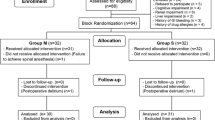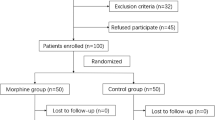Abstract
Purpose
Severe post-operative pain is one of the main problems after total knee arthroplasty. In this study, we investigated the effect of a peri-articular multimodal drugs injections pre-emptively on post-operative pain control and knee functions following total knee arthroplasty.
Methods and materials
This study was a double-blind randomized clinical trial. Eligible cases including 137 patients—aged 30 to 80 years old—were randomly divided into one of two groups: the drug group received a cocktail consisting of bupivacaine hydrochloride, morphine sulphate, epinephrine, and ketorolac. The control group received epinephrine only. The injections were given 15 minutes before incision. Joint range of motion (ROM) and the severity of pain by using visual analog scale (VAS) of 1 to 10 and patient’s facial expression, were assessed in the pre-operative visit, after 24 hours, 48 hours, and six weeks after operation. Knee Society score (KSS) was recorded before the operation, six weeks, and six months after the operation for each patient.
Results
The data of VAS showed no significant difference between the groups before operation but there was statistically significant difference between the two groups at 24 hours, 48 hours, and six weeks after the operation. In KSS, difference was not significant between the two groups before the operation and six months after surgery while our results showed a statistically significant difference between groups six weeks after the operation. In ROM, there was no significant difference between the groups before operation. There was a statistically significant difference between the two groups at 24 hours, 48 hours and six weeks after the operation. Complications were recorded at six weeks after surgery.
Conclusion
Peri-articular multimodal injection including bupivacaine, morphine, and ketorolac preferably with pre-emptive injection method provided proper post-operative pain relief, less opioid consumption, and better early rehabilitation following TKA at 48 hours after surgery.
Level of study
Level I.



Similar content being viewed by others
References
Koh IJ, Chang CB, Lee JH, Jeon YT, Kim TK (2013) Preemptive low-dose dexamethasone reduces postoperative emesis and pain after TKA: a randomized controlled study. Clin Orthop Relat Res 471(9):3010–3020
Li D, Tan Z, Kang P, Shen B, Pei F (2016) Effects of multi-site infiltration analgesia on pain management and early rehabilitation compared with femoral nerve or adductor canal block for patients undergoing total knee arthroplasty: a prospective randomized controlled trial. Int Orthop. doi:10.1007/s00264-016-3278-0
Kim TW, Park SJ, Lim SH, Seong SC, Lee S, Lee MC (2015) Which analgesic mixture is appropriate for periarticular injection after total knee arthroplasty? Prospective, randomized, double-blind study. Knee Surg Sports Traumatol Arthrosc 23(3):838–845
Busch CA, Shore BJ, Bhandari R, Ganapathy S, MacDonald SJ, Bourne RB, Rorabeck CH, McCalden RW (2006) Efficacy of periarticular multimodal drug injection in total knee arthroplasty. A randomized trial. J Bone Joint Surg Am 88:959–963
Dahl JB, Møiniche S (2004) Pre-emptive analgesia. Br Med Bull 71:13–27
Bantel C, Trapp S (2011) The role of the autonomic nervous system in acute surgical pain processing—what do we know? Anaesthesia 66(7):541–544
Soltesz S, Meiger D, Milles-Thieme S, Saxler G, Ziegeler S (2016) Intermittent versus continuous sciatic block combined with femoral block for patients undergoing knee arthroplasty. A randomized controlled trial. Int Orthop 40(9):1861–1867
Kasture S, Saraf H (2015) Epidural versus intra-articular infusion analgesia following total knee replacement. J Orthop Surg (Hong Kong) 23(3):287–289
Song MH, Kim BH, Ahn SJ, Yoo SH, Kang SW, Kim YJ, Kim DH (2016) Peri-articular injections of local anaesthesia can replace patient-controlled analgesia after total knee arthroplasty: a randomised controlled study. Int Orthop 40(2):295–299
McElroy MJ, Pivec R, Issa K, Harwin SF, Mont MA (2013) The effects of obesity and morbid obesity on outcomes in TKA. J Knee Surg 26(2):83–88
Markatos K, Kaseta M, Nikolaou VS (2015) Perioperative skin preparation and draping in modern total joint arthroplasty: current evidence. Surg Infect (Larchmt) 16(3):221–225
Wolfe F, Simons DG, Fricton J, Bennett RM, Goldenberg DL, Gerwin R, Hathaway D, McCain GA, Russell IJ, Sanders HO et al (1992) The fibromyalgia and myofascial pain syndromes: a preliminary study of tender points and trigger points in persons with fibromyalgia, myofascial pain syndrome and no disease. J Rheumatol 19(6):944–951
Obaid-Ur-Rahman HS, Amin MS, Ameen J, Adnan R (2015) Early release of tourniquet in total knee arthroplasty: is it worthwhile? J Pak Med Assoc 65:S77–S81
Warwick D (2012) Prevention of venous thromboembolism in total knee and hip replacement. Circulation 125(17):2151–2155
Canale TS, Beaty JH (2013) Arthroplasty of the knee. Campbell’s operative orthopaedics, 12th edn. Elsevier, Canada, pp 376–450
Tsukada S, Wakui M, Hoshino A (2015) Pain control after simultaneous bilateral total knee arthroplasty: a randomized controlled trial comparing periarticular injection and epidural analgesia. J Bone Joint Surg Am 97(5):367–373
Meftah M, Wong AC, Nawabi DH, Yun RJ, Ranawat AS, Ranawat CS (2012) Pain management after total knee arthroplasty using a multimodal approach. Orthopedics 35(5):660–664
Parvizi J, Porat M, Gandhi K, Viscusi ER, Rothman RH (2009) Postoperative pain management techniques in hip and knee arthroplasty. Instr Course Lect 58:769–779
Yuenyongviwat V, Pornrattanamaneewong C, Chinachoti T, Chareancholvanich K (2012) Periarticular injection with bupivacaine for postoperative pain control in total knee replacement: a prospective randomized double-blind controlled trial. Adv Orthop 107309
Bramlett K, Onel E, Viscusi ER, Jones K (2012) A randomized, double-blind, doseeranging study comparing wound infiltration of DepoFoam bupivacaine, an extended-release liposomal bupivacaine, to bupivacaine HCL for postsurgical analgesia in total knee arthroplasty. Knee 19(5):530
Yue DB, Wang BL, Liu KP, Guo WS (2013) Efficacy of multimodal cocktail periarticular injection with or without steroid in total knee arthroplasty. Chin Med J (Engl) 126(20):3851–3855
Lee WC, Kwan YH, Chong HC, Yeo SJ (2016) The minimal clinically important difference for Knee Society Clinical Rating System after total knee arthroplasty for primary osteoarthritis. Knee Surg Sports Traumatol Arthrosc. doi:10.1007/s00167-016-4208-9
Andersen KV, Nikolajsen L, Haraldsted V, Odgaard A, Local SK (2013) infiltration nalgesia for total knee arthroplasty: should ketorolac be added? Br J Anaesth 111(2):242–248
Kelley TC, Adams MJ, Mulliken BD, Dalury DF (2013) Efficacy of multimodal perioperative analgesia protocol with periarticular medication injection in total knee arthroplasty: a randomized, double-blinded study. J Arthroplasty 28(8):1274–1277
Acknowledgements
The authors wish to express their thanks to all hospital personnel involved in this study for their cooperation. We also express our especial thanks to Prof. Azim Honarmand, a faculty member at the Department of Anesthesiology affiliated with the Isfahan University of Medical Sciences for their cooperation with us in the scientific revision.
Author information
Authors and Affiliations
Corresponding author
Ethics declarations
Conflict of interest
The authors of this study have no conflict of interests.
Funding source
This work was supported by the Medical Research Council at Isfahan University of Medical Sciences.
Ethical approval
The protocol of this study was approved by the Ethics Committee and the review board of the Isfahan University of Medical Sciences (Project No. 394048, Clinical Trial Registration No. IRCT2016073129132N2). This study was performed only on humans. This article does not contain any previous phases on human participants or animals performed by any of the authors. The manuscript has not been submitted to other journals. The manuscript has not been published previously (partly or in full). No data have been fabricated or manipulated (including images) to support our conclusions. We have not used any data, text or theories presented by others in this study at all. In the section of discussion, all subjects presented by others are mentioned with their references. So there is no plagiarism.
Informed consent
Informed consent was obtained from all individual participants included at the beginning of the study.
Rights and permissions
About this article
Cite this article
Motififard, M., Omidian, A. & Badiei, S. Pre-emptive injection of peri-articular-multimodal drug for post-operative pain management in total knee arthroplasty: a double-blind randomized clinical trial. International Orthopaedics (SICOT) 41, 939–947 (2017). https://doi.org/10.1007/s00264-016-3357-2
Received:
Accepted:
Published:
Issue Date:
DOI: https://doi.org/10.1007/s00264-016-3357-2




